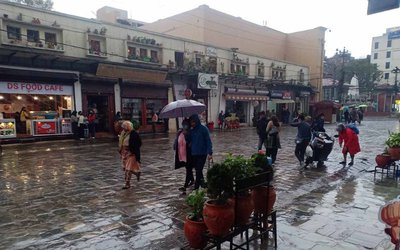The CEO of the National Reconstruction Authority Satish Gyewali was hauled up by the PM for clarification and is in the process of being sacked. Lokman Singh Karki, chief of CIAA is facing impeachment in Parliament for improper functioning. It seems that some accountability is being sought. But who are our politicians and even beaurocrats answerable to? Is it to God? It is highly unlikely that they will go directly to heaven. The more likely fact is that in our part of the world all will be soon forgotten and forgiven. Life has never been better for those at the helm of affairs as it functions according to: 'Mere Goruko Bahrai Takka'.
Our PMs, following the setting up of our Federal Republic, have been flouting the law. Our present crops of leaders are experts in playing musical chairs and know how to satisfy the needs of the 'foreign hand' that always pats their backs. Some local bravado was shown when one PM initiated the road development works in the capital and elsewhere. We are at the cross roads again, with three elections to be conducted in the next fifteen months. The sad part is that our politicians of all the different shades are quarrelling and displaying their individual idiosyncrasy and holding the country to ransom. The truth is that they want to fish in the dirty waters. Is it a ploy to postpone elections and the implementation of a Constitution that is our very own?
Two winters have gone since the earthquake of April 2015 and the people have still to get relief. Things are at standstill. Nepal Rastra Bank, which has the Nation's money bags, has not been able to start construction of its own major buildings in the capital that were damaged by the earthquake, though the permission to do so has been given by the Government. Our government as a general rule makes pronouncements which itself does not heed. Following the earthquakes of 2015 when a number of people were killed by huge boundary walls falling, the government stipulated that such structures must only be 5 feet and be topped with non hazardous light railings. Though the idea was that pedestrians should not meet sudden deaths, the authorities went on to build at a very fast pace, the ten feet or even taller northern wall of the Singha Durbar compound, ignoring the very rules that it had been laid down. Why? Was there a hidden beaurocratic agenda? In contrast the cracked or fallen walls on all four sides of the Naranhity Durbar and the Southern Gate of the durbar which can fall any time seem to be of little concern. Have these disfigured sights been left so that tourists can take snaps as memories of their visit to Nepal? Cannot these eyesores in the capital be torn down and the walls be shifted further inside so that the ever increasing traffic of the capital flow more easily?
Another reality is that all the old Rana palaces which had been built using mud or bazra, chaku, maasko dal, bhush and chun have mostly stood for a hundred years and provided government offices in the town. The earthquake of 2015 damaged almost all of them and for safety's sake all must be pulled down. We need to remember that following the fire of 1973 at Singha Durbar, most of the structures were demolished and rebuilt using modern technology and materials. The old facade was retained. One recollects too that many years ago the Institute of Engineering had renovated the Ananda Bhawan building in Pulchowk as an example of architecture of Rana days. Is it necessary to save any more of these? Regarding Singha Durbar one read in the papers that the front is not going to be retrofitted but demolished and rebuilt the modern way. A few days later came a new statement that there is no decision on that. All very confusing as one ponders over it. Perhaps even the Gaddi Baithak at Basantapur, which was rebuilt with a modern facade after the earthquake of 1934 should be demolished and rebuilt with modern materials, resembling the original building that stood there. The new structures should also not be hazardous to tourists and us, the local visitors.
One has only to think back to the Dharahara which had been rebuilt in the past with old technology and as a result took sixty Nepali lives in April 2015. Why can't we have a modern structure of steel like the Eifel Tower of Paris, with lifts in its interior but with an artificial, all weather, plastic like white covering to make it look like the original ‘folly’ of Bhimsem Thapa! Another case in point is the Durbar High School, together with two other entities also located there in a cramped state. As one passes by and sees the post earthquake rubble of Kathmandu still dumped in the Tundikhel one wonders if the government functions at all.
Then one recalls the recent fiasco regarding the Balgopaleswar Mandir in the centre of Ranipokhari. Some Heritagewallahs, prodded by various interests are even forbidding the use of modern materials such as cement in the construction process. However visiting Durbar Square in Bhaktapur one is surprised seeing just chun and the local’s insistence that it is strong. We should in fact use more earthquake resistant or more appropriate materials that are not risks to future generations of Nepalis who will visit such temples. The external facade should be such that worshippers are not at risk when the earth rumbles again in this part of the world. Another sad story is that of the Kalmochan temple built at Tripureshwar by Jung Bahadur. It too needs to be built as it was but in such a manner that it is not a risk to visitors.
In contrast the Kathmandu – Bhaktapur highway was repaired by representatives of Japanese contractors within a couple of months of the earthquake. Half of an overhead pedestrian crossing on the same highway still remains to be repaired by our Roads Department almost twenty months after that same catastrophe!
The question now remaining is the bandh carried out by citizens of Kathmandu valley demanding compensation due for the houses demolished for the cause of road widening. When there is such a long gap between what is promised but not given nor delivered, it is but natural that no one trusts the government in power.
The author writes fiction under the name of Mani Dixit. Website: www.hdixit.org.np. Twitter: @manidixithd

Hemang Dixit
The author writes fiction under the name of Mani Dixit. Website: www.hdixit.org.np. Twitter: @manidixithd
- Top Heavy
- Sep 20, 2023
- Most Able?
- Sep 04, 2023
- Changing Times
- Aug 21, 2023
- Nepali Shenanigans
- Aug 03, 2023
- Budget Naataks
- Jun 29, 2023














